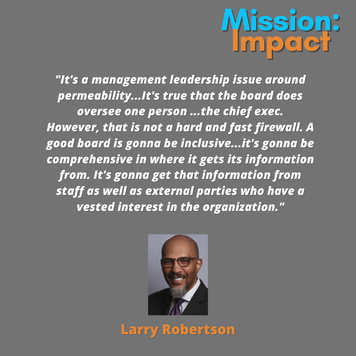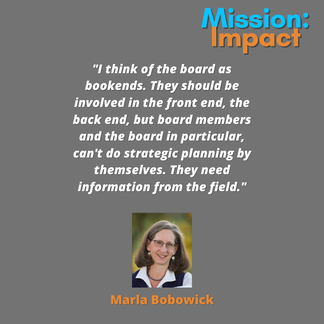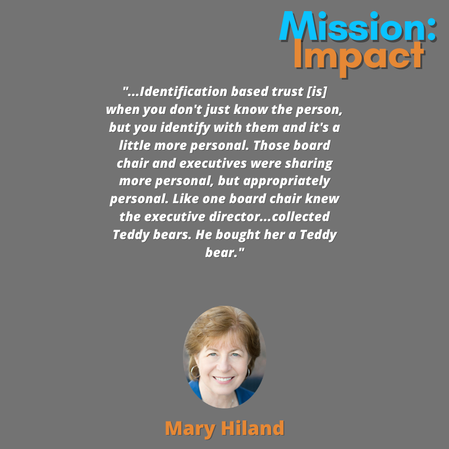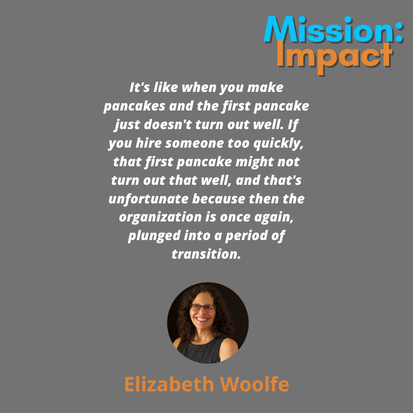Mission: Impact podcast & blog
Build a better world without becoming a martyr to your nonprofit cause
Listen on:
 In episode 99 of Mission: Impact, Carol Hamilton and Mary Reeves, PhD discuss:
Episode highlights: Ethical Nonprofit Governance - [00:06:00] The importance of ethical and proper governance in educational organizations. The Concept of Ikigai - [00:07:20] The Japanese principle of Ikigai and its four components: what you love, what you are good at, what the world needs, and what you can get paid for. Building positive Nonprofit Board and Executive Director Relationships - [00:08:35] The importance of fostering positive relationships between the board and executive directors. Transformational nonprofit board experiences - [00:011:34] The transformational experience board members often undergo. Managing Conflicts of Interest and Fiduciary Responsibilities - [00:18:26] The inherent conflicts of interest in many association boards and the importance of understanding fiduciary responsibilities. Elevating Nonprofit Board Service - [00:22:20] The high stakes of decision-making in board service and how it can be a transformational experience by rising above personal experiences and biases in board service. Progress over perfection - [00:28:43] Leaders should recognize they cannot do it all and should focus on progress rather than perfection. Guest Bio:
Mary H Reeves, PhD Mary Reeves is the retired executive director of the Commission on English Language Program Accreditation (CEA), the current public member on the Council on Academic Accreditation of ASHA, and a member of the NAFSA: Association of International Educators Board of Directors Governance Committee. Her non-profit board experiences span 50 years, both on the board-side in local service organizations and national leadership positions in professional associations in English language and international education, and in staff-side associate and executive director positions. She now focuses on effective transitions, proactive mentoring, and how to maximize contributions of knowledge, experience, and passion while gracefully passing the torch. Mary holds a PhD in higher education policy studies with a primary focus in international education and a secondary focus in organizational behavior. Important Links and Resources: Leadership without Easy answers by Ronald Heifetz BoardSource Related Episodes: Episode 15: The Nonprofit Executive director – Board chair leadership Episode 42: Building shared governance Episode 55: Helping nonprofit boards move toward greater equity Episode 61: Impactful nonprofit boards Click "Read More" for a transcript of the interview  In episode 61 of Mission: Impact, Carol and her guest, Larry J. Robertson discuss:
Guest Bio: Larry Robertson is an organizational development and certified governance consultant who specializes in helping nonprofit and state and local governments assess, plan, and improve organizational strategies, governance, leadership, and talent. His work includes organizational assessments, strategic planning, strategy coaching, nonprofit board development and transformation, and talent management. He tailors services to fit the needs and aspirations of each organization through an appropriate mix of analytic consulting, coaching, training, facilitation, and product development. Larry has extensive experience offering these services to organizations that range from small, startup nonprofits to large, mature state and municipal agencies. He has an M.A. in Human Development from the University of Maryland and a B.A. in Psychology from the University of Miami. Important Links and Resources:
Click "Read More" for Transcript:  In Episode 42 of Mission: Impact, Carol and her guest, Marla Bobowick discuss:
Guest Bio: Marla Bobowick is an independent consultant based in Washington, DC, has served as a Senior Governance Consultant for BoardSource since 2008, and is also a Standards for Excellence® licensed consultant. She has more than 30 years of nonprofit experience and a history of creative problem solving. Specializing in nonprofit management and leadership, she has extensive experience with board governance, strategy, and publishing. She has worked with nonprofit organizations of all types and sizes, including regional healthcare and social service providers, educational institutions (independent schools and colleges and universities), family and other private foundations, and local and national offices of federated organizations and professional associations. Previously, Marla was Vice President of Products at BoardSource, where she oversaw publications, online products, and research. During her tenure at BoardSource, she was an active consultant and trainer, developed educational curriculum, managed regional capacity building projects, oversaw the global program, and coordinated the annual conference. While at BoardSource, Marla managed Leading with Intent: A National Index of Nonprofit Board Practices. She was also a member of the working group for The Source: Twelve Principles of Governance That Power Exceptional Boards (BoardSource © 2005). She managed “Governance Futures: New Perspectives on Nonprofit Governance,” a multiyear research project that culminated in publication of Governance as Leadership: Reframing the Work of Nonprofit Boards (John Wiley & Sons © 2005). She is co-author of Assessing Board Performance: A Practical Guide for College, University, System, and Foundation Boards (Association of Governing Boards of Universities and Colleges © 2018). Previously, Marla was an acquisitions editor at John Wiley & Sons, where she developed Wiley’s Nonprofit Law, Finance, and Management Series and the Association of Fundraising Professionals Fund Development Series. Marla holds a bachelor’s degree in English from Amherst College, a master’s degree in business administration and a certificate in nonprofit management from Case Western Reserve University. She is a past board chair of Maryland Nonprofits and a past board member Calvary Women’s Services. Important Links and Resources:
Click "Read More" for Transcript:  In episode 15 of Mission: Impact, some of the topics that Carol and her guest, Mary Hiland discussed include:
- The role of the board in day-to-day operations Guest Information: Mary Hiland brings over 40 years of experience to nonprofit leaders to create a paradigm shift about how to develop an informed and inspired board that is truly an asset. Her mission is to help nonprofit leaders ignite and unleash the potential of the board, getting rid of the mindset that a board is a burden. Her deep expertise and hands-on experience (26 years as a nonprofit executive and 17 as a board member) bring credibility and confidence to nonprofit leaders who know she understands because she’s “been there.” Mary coaches, and mentors executive directors and board leaders. She is a speaker and published author. She has a weekly podcast, Inspired Nonprofit Leadership: conversations to inspire, inform, and support nonprofit leaders. Links:
Click "Read More" for Transcript:  In episode 12 of Mission: Impact, some of the topics that Carol and her guest, Elizabeth Woolfe, discussed include: ● The importance of an interim director for nonprofit organizations ● The process of transitioning and the strain that puts on a nonprofit organization ● The importance of having a plan in place for when your leader leaves ● Growth mindset with Nonprofit Boards ● What the role of the Board and the role of the staff are in an organization and how those differ ● The importance of taking breaks for yourself Guest Information: Elizabeth Woolfe is a lifelong nonprofit professional with expertise in affecting strategic change and facilitating growth for organizations, as well as in assisting boards and organizations through transitions.She also has strength in building philanthropic relationships between nonprofit and for-profit companies, facilitating collaborations, and program development. Her particular areas of interest are interim leadership, management of organizations and boards, strategic assessment, organizational development, board functionality, and relationship building. Links: Click "Read More" for Transcript: |
Categories
All
Archives
July 2024

Grace Social Sector Consulting, LLC, owns the copyright in and to all content in and transcripts of the Mission: Impact podcast, as well as the Mission: Impact blog with all rights reserved, including right of publicity.
|
Telephone301-857-9335
|
info[at]gracesocialsector.com
|
Grace Social Sector Consulting, LLC, owns the copyright in and to all content in, including transcripts and audio of the Mission: Impact podcast and all content on this website, with all rights reserved, including right of publicity.
|